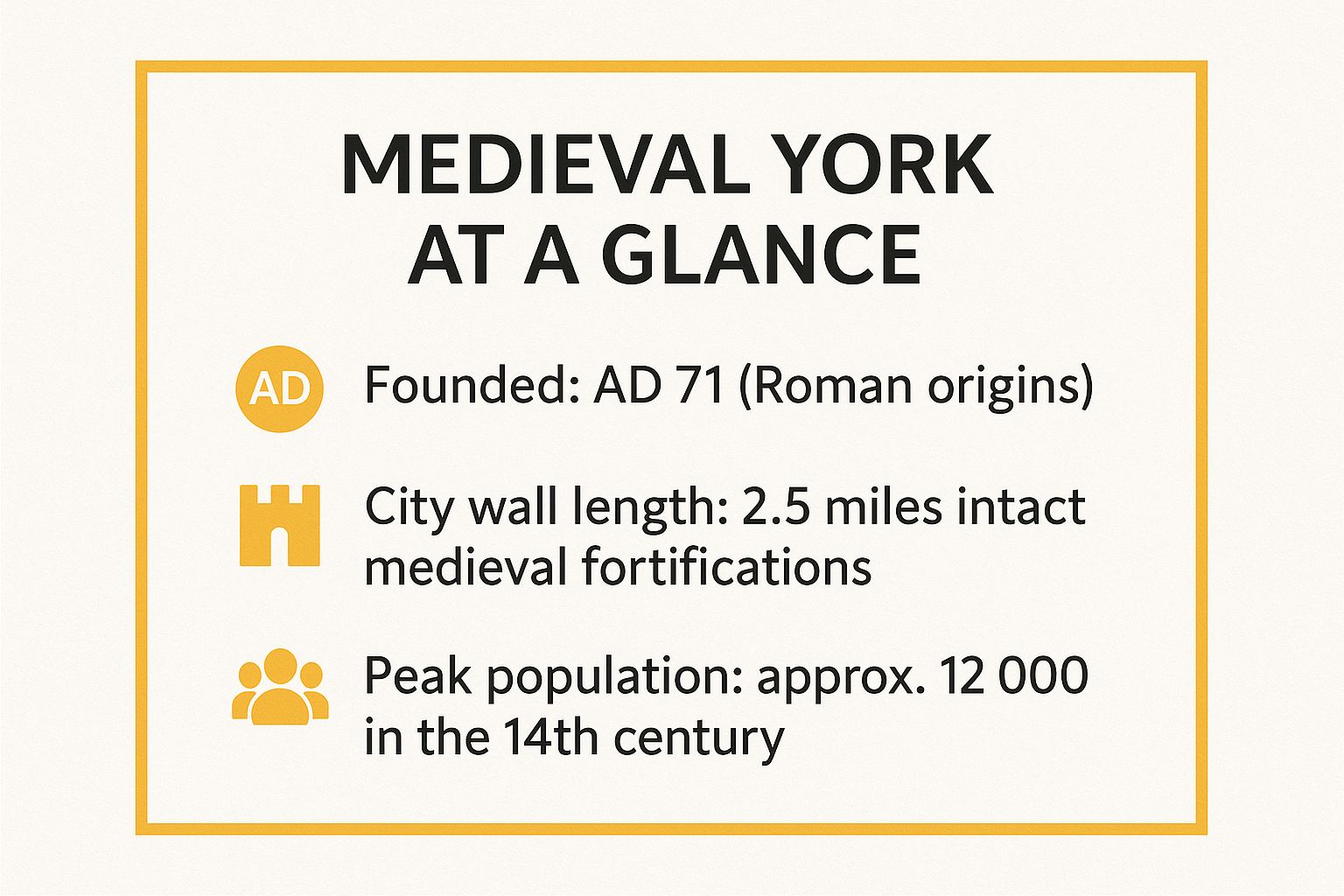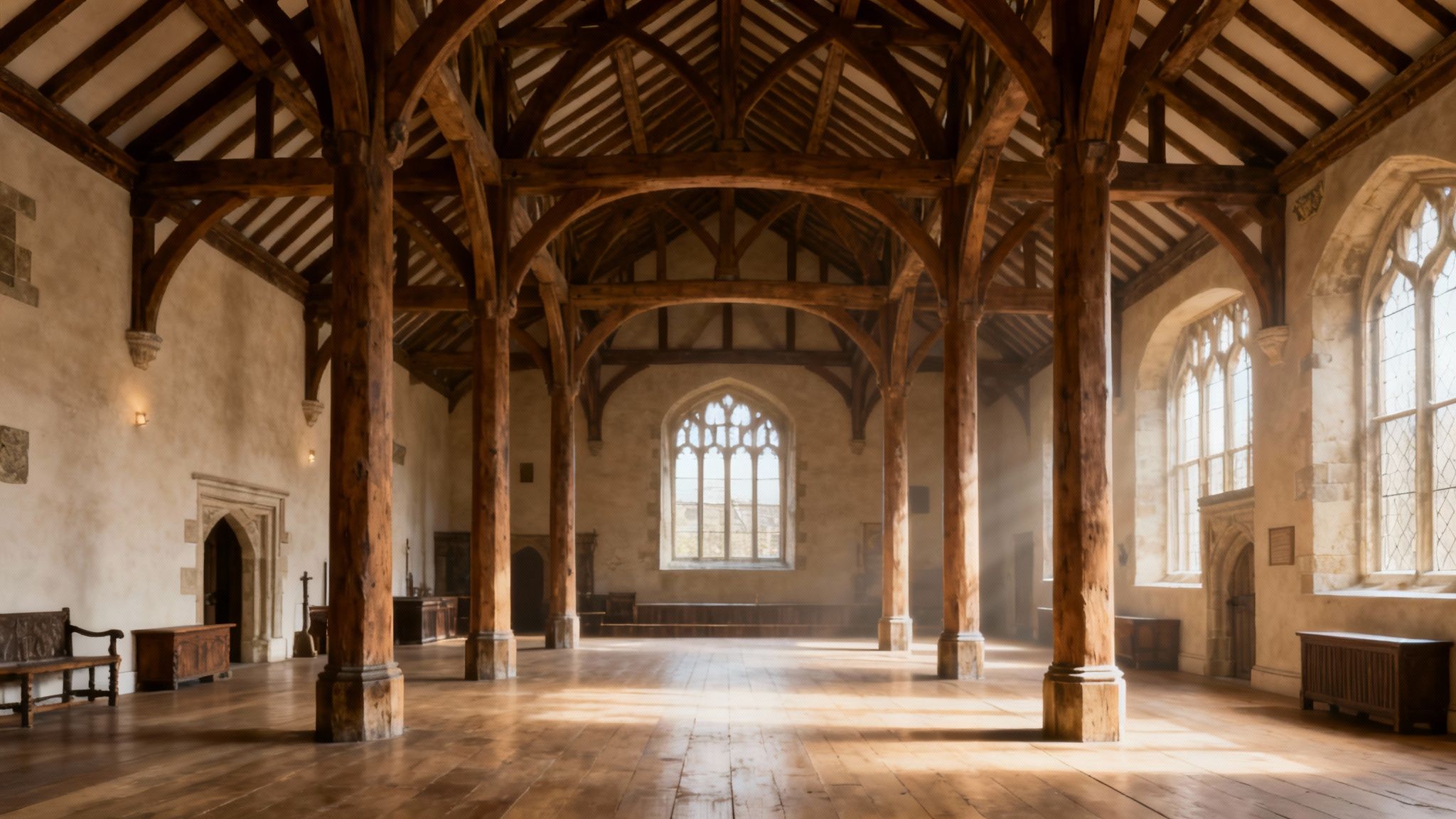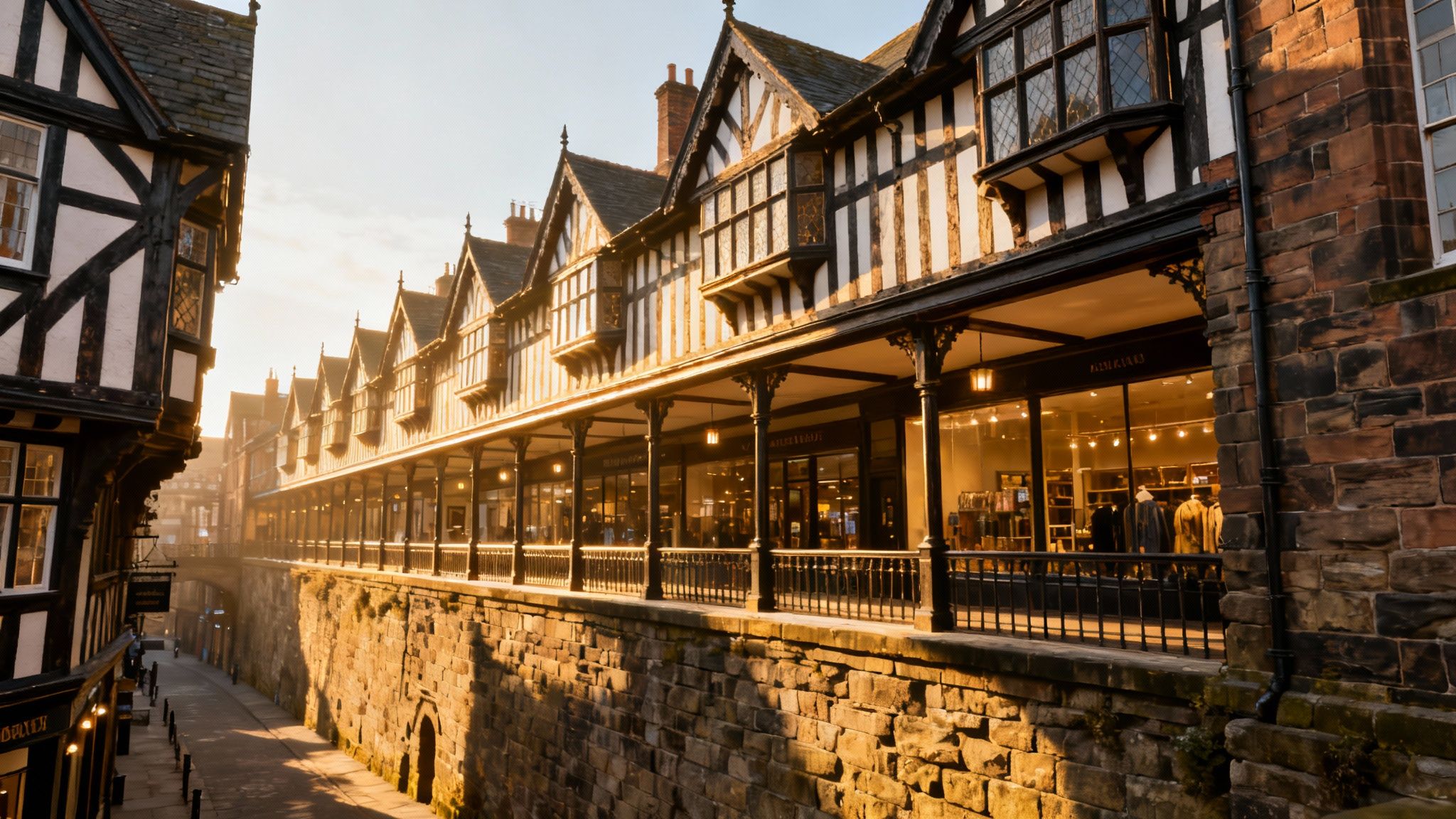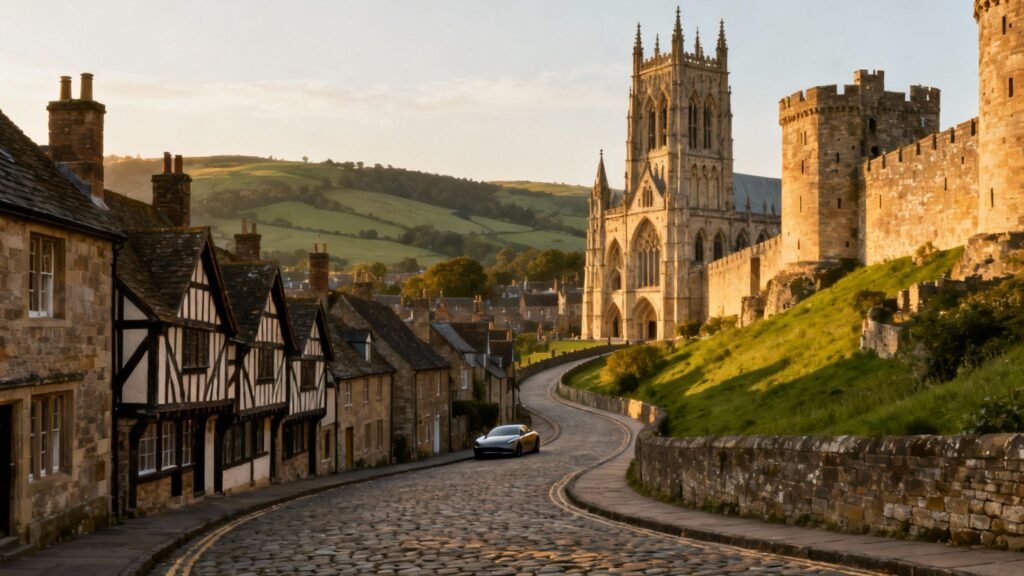England's story is written in stone, in the soaring spires of its cathedrals, the formidable walls of its castles, and the winding cobbled streets of its ancient urban centres. Long after the clatter of armour and the bustle of medieval markets have faded, these places remain living museums, offering a direct portal to a past shaped by pilgrimage, power, and prosperity. For history enthusiasts and independent travellers, exploring these historic hubs is an unparalleled experience.
This guide is a curated journey through eight of the most compelling medieval cities in England. We move beyond a simple list, offering actionable insights to help you plan your visit. We will uncover each city's unique history, from Viking strongholds to centres of religious importance, and highlight the must-see landmarks that define their character. For those planning a trip from abroad, it's essential to first familiarise yourself with current entry requirements, including the new UK Electronic Travel Authorization (ETA) system, to ensure a smooth arrival.
This article provides a practical blueprint for the modern explorer. For those who prefer to travel at their own pace, a self-drive tour offers the perfect way to connect these destinations, transforming a simple holiday into an epic historical adventure. Let's begin our exploration.
1. York (Eboracum/Jorvik)
York stands as a monumental testament to England’s layered past, making it one of the most compelling medieval cities in England. Founded by the Romans as Eboracum in AD 71, it later became the formidable Viking capital of Jorvik. By the Middle Ages, York had blossomed into the ecclesiastical heart of northern England and a powerful centre for trade, thanks to its strategic position at the confluence of the Rivers Ouse and Foss.
This rich history is not just confined to museums; it is etched into the very fabric of the city. From the imposing York Minster, one of the world's most magnificent cathedrals, to the labyrinthine medieval streets, every corner tells a story. The city's enduring legacy is a powerful draw for anyone seeking an authentic glimpse into England’s medieval world.
Key Landmarks and Experiences
York’s preservation of its past is remarkable. The Shambles, a narrow, cobbled street with overhanging timber-framed houses, famously inspired Diagon Alley in the Harry Potter films and offers an immersive medieval experience. For a comprehensive understanding of the city's structure, a walk along the complete circuit of its beautifully preserved medieval Bar Walls is essential. These walls, once a vital part of the city's defences, now offer stunning panoramic views.
A visit to the JORVIK Viking Centre is crucial to grasp the city's pre-Norman roots. Built on the site of a major archaeological dig, it vividly reconstructs the sights, sounds, and even smells of the Viking-age city. For a truly atmospheric experience, attend an Evensong service at York Minster to hear choral music fill its vast, historic halls.
For a quick reference, this infographic summarises York's historical significance.

The data highlights York's deep Roman origins, extensive medieval fortifications, and its substantial population during the medieval era, cementing its status as a major European city.
Planning Your Visit
To truly appreciate York's medieval character, timing is everything. Explore the city’s ancient streets like The Shambles in the early morning or late evening to avoid the crowds and capture a sense of their historic solitude.
- Accommodation: Consider staying within the city walls for the most immersive experience. Properties like Grays Court Hotel offer historic charm directly in the shadow of York Minster.
- Self-Drive Route: York is a key stop on the A64 scenic route. From Leeds, it’s a direct 45-minute drive. For a more historic approach, drive from the south via the A1(M) and A64, tracing ancient Roman and medieval travel routes.
- Travel Tip: While driving to York is straightforward, the medieval centre is best explored on foot. Use the city’s excellent Park & Ride services to avoid navigating the narrow, restricted streets.
2. Canterbury
Canterbury’s story is defined by faith, power, and pilgrimage, securing its place among the most significant medieval cities in England. Its spiritual importance was established in 597 AD when St Augustine founded his monastery, making it the epicentre of English Christianity. However, it was the dramatic murder of Archbishop Thomas Becket within Canterbury Cathedral in 1170 that transformed the city into one of Europe's foremost pilgrimage destinations, immortalised in Geoffrey Chaucer’s The Canterbury Tales.
This influx of pilgrims shaped the city’s economy, architecture, and very identity throughout the Middle Ages. Its legacy is not merely a historical footnote but a living presence, evident in the magnificent cathedral that dominates the skyline and the ancient streets that once teemed with devout travellers from across the christened world.
Key Landmarks and Experiences
Canterbury offers a journey into the heart of medieval devotion. The awe-inspiring Canterbury Cathedral, a UNESCO World Heritage Site, is the primary draw. Visitors can stand on the very spot in the northwest transept where Becket was martyred. For a deeper understanding of the city's early medieval roots, exploring the atmospheric ruins of St Augustine's Abbey is essential.
To fully grasp the pilgrim experience, visit the Eastbridge Hospital of St Thomas the Martyr, a remarkably preserved medieval almshouse that provided lodging for poor pilgrims. A walk along the surviving sections of the medieval city walls reveals the city's defensive architecture and provides excellent views. These sites collectively offer a powerful insight into the religious and social fabric of medieval life. Learn more about planning your trip to Canterbury on btours.com.
Planning Your Visit
To connect with Canterbury's profound history, consider the context of pilgrimage. Reading a modern translation of The Canterbury Tales before you arrive will enrich your understanding of the city's medieval cultural peak.
- Accommodation: Stay in a historic inn like The Sun Hotel, which has been welcoming travellers since the 15th century, to capture the spirit of a medieval pilgrim.
- Self-Drive Route: Canterbury is easily accessible via the M2 from London. For a more scenic and historic drive, take the A2, which follows the path of the ancient Roman road of Watling Street, the primary route for medieval pilgrims travelling from the capital.
- Travel Tip: The city centre is a compact and largely pedestrianised conservation area. Park at one of the city's Park & Ride locations and explore the narrow lanes, cathedral precincts, and riverside paths on foot for the most authentic experience.
3. Winchester
Winchester holds a unique and powerful claim as one of the most historically significant medieval cities in England, having served as the capital of the Anglo-Saxon kingdom of Wessex and, effectively, of England itself. Long before London's ascent, Winchester was the epicentre of royal power and religious authority, home to legendary figures like King Alfred the Great. Its status as the seat of one of England's wealthiest bishoprics ensured its enduring influence throughout the medieval period.
The city’s legacy is a compelling blend of royal history, religious scholarship, and enduring tradition. From its grand cathedral, the final resting place of early English kings, to the echoes of Arthurian legend in its Great Hall, Winchester offers a profound connection to the foundations of the English nation. This deep-rooted heritage makes it an essential destination for anyone tracing the story of medieval England.
Key Landmarks and Experiences
Winchester's medieval treasures are both monumental and intimate. In the Great Hall, the last surviving part of Winchester Castle, hangs the iconic Arthurian Round Table. This stunning 13th-century artefact, though not from Arthur's time, vividly illustrates the medieval world's fascination with the legend. For a glimpse into the city's spiritual and artistic zenith, the Winchester Bible, a masterpiece of Romanesque art housed in the Cathedral library, is an unmissable sight.
A truly unique experience is receiving the Wayfarer's Dole at the Hospital of St Cross, a charitable tradition of offering a small horn of beer and a piece of bread that has continued uninterrupted for over 900 years. To understand the city’s educational legacy, a visit to Winchester College, founded in 1382, reveals the architectural model for England's famous public school system.
Planning Your Visit
To fully immerse yourself in Winchester's ancient past, plan your explorations around its most significant historic sites, many of which are clustered together. A walk along the medieval High Street from the Westgate reveals a fascinating progression of architectural styles.
- Accommodation: Stay near the cathedral for an atmospheric experience. The Wykeham Arms is a historic inn offering traditional charm just a stone's throw from both the Cathedral and Winchester College.
- Self-Drive Route: Winchester is a highlight of any tour through southern England. It is easily accessible from London via the M3 motorway. For a more scenic journey, take the A31 through the picturesque South Downs National Park, a route that echoes ancient pathways. Winchester is a perfect stop when exploring the broader region, and you can learn more about its place in a Taste of South England and Wales tour.
- Travel Tip: The medieval core of Winchester is compact and pedestrian-friendly. Park your car in one of the city's long-stay car parks and explore on foot to appreciate the scale and detail of its historic streets and buildings.
4. Norwich
Norwich was a powerhouse of the Middle Ages, rising to become England's second-largest and wealthiest city outside of London by the 14th century. Its immense prosperity was built on the lucrative wool and textile trade, fostering strong commercial ties with continental Europe. This wealth funded an extraordinary urban landscape, including a magnificent cathedral, a formidable castle, and an unparalleled concentration of 57 medieval parish churches within its city walls.

The city’s layout, a dense network of streets and alleys, remains remarkably intact, offering an authentic glimpse into the bustling life of a major medieval commercial hub. Norwich's legacy is one of trade, civic pride, and architectural ambition, making it an essential destination for anyone exploring the great medieval cities in England.
Key Landmarks and Experiences
Norwich offers a deep dive into the life of a medieval merchant city. A walk through the Norwich Lanes is essential, as this historic network of alleyways maintains its traditional character, lined with independent shops that echo its commercial past. To understand the domestic and business life of a wealthy merchant, visit Strangers' Hall, a fascinating museum showcasing the evolution of a city house from 1320 onwards.
For a unique insight into medieval commerce, explore Dragon Hall, a stunningly restored 15th-century trading hall. To grasp the scale of the city's religious devotion and architectural variety, make a point of visiting several of its surviving medieval churches. No visit is complete without exploring the magnificent Norwich Cathedral, with its soaring spire and the largest monastic cloisters in England.
Planning Your Visit
To get a true feel for Norwich's medieval urban density, explore its historic core on foot. The compact city centre is rich with architectural treasures tucked away in its labyrinthine streets.
- Accommodation: Stay in the heart of the city to be within walking distance of all major sites. The Maids Head Hotel claims to be the oldest hotel in the UK, offering a stay steeped in history opposite the cathedral.
- Self-Drive Route: Norwich is the hub of East Anglia. It's easily reached via the A11 from London and Cambridge. A scenic drive on the A140 from Ipswich takes you through the classic Suffolk and Norfolk countryside.
- Travel Tip: Climb the mound of Norwich Castle for an unparalleled panoramic view of the medieval city. This perspective helps you appreciate the sheer density of the historic churches and the distinct layout of the ancient street plan.
5. Lincoln
Lincoln’s dramatic hilltop position, crowned by its magnificent cathedral, makes it one of the most visually stunning medieval cities in England. With Roman foundations and immense Norman influence, Lincoln grew into a powerhouse of the Middle Ages. Its wealth, derived from the booming wool trade, and its status as a major administrative centre are reflected in its formidable castle and ecclesiastical buildings.
The city’s geography created a distinct medieval social structure. The "Uphill" area was the domain of the cathedral and the castle, representing ecclesiastical and noble power, while the "Downhill" area bustled with the commercial and daily life of its citizens. This historic division remains palpable today, offering a unique insight into the medieval urban landscape.
Key Landmarks and Experiences
Lincoln’s medieval treasures are exceptionally well-preserved and deeply significant. A visit to Lincoln Castle is essential, as it houses one of only four surviving original copies of the 1215 Magna Carta, a cornerstone of modern democracy. Inside the spectacular Lincoln Cathedral, visitors can search for the famous ‘Lincoln Imp’, a mischievous stone carving that has become a symbol of the city.
For a deeper understanding of the Church's immense power during the Middle Ages, explore the ruins of the Medieval Bishop's Palace. This English Heritage site reveals the scale and wealth commanded by Lincoln's bishops. A walk up the aptly named Steep Hill, a beautiful cobbled street lined with independent shops, directly connects the commercial lower city with the powerful upper city, physically tracing its historic social divide.
Planning Your Visit
To best experience Lincoln’s unique character, plan your exploration around its topography. Tackle the demanding but rewarding Steep Hill in the early morning to appreciate its medieval architecture without the crowds.
- Accommodation: Stay in the Cathedral Quarter for an atmospheric experience. The White Hart Hotel, located between the castle and cathedral, offers historic charm and convenience.
- Self-Drive Route: Lincoln is accessible via the A1 and A46. From the south, driving from London via the A1(M) offers a direct route. For a scenic approach, take the A15 north from Peterborough, traversing the historic Lincolnshire countryside.
- Travel Tip: While a car is great for reaching Lincoln, the historic Uphill area is best explored on foot. Use the plentiful city centre car parks and be prepared for a steep but memorable walk. For those who prefer not to drive, Lincoln is also well-connected by rail, a convenient option highlighted in our guide to exploring Britain by train.
6. Chester
Chester is a truly unique destination among medieval cities in England, distinguished by its almost perfectly preserved city walls and the one-of-a-kind ‘Rows’. Founded by the Romans as the fortress Deva Victrix, it remained a site of immense strategic importance throughout the Middle Ages, serving as a key military base against Wales and a bustling port for trade across the Irish Sea.

This legacy of continuous occupation created a city where Roman foundations support medieval structures, which in turn are framed by Victorian revival architecture. The city’s commercial heart still beats in the same spaces it has for centuries, offering a tangible connection to its medieval past that feels both authentic and alive. Chester’s ability to blend its history into a vibrant, modern city makes it an essential stop for any history enthusiast.
Key Landmarks and Experiences
Chester’s architectural heritage offers an unparalleled glimpse into medieval urban life. The Chester Rows are its most famous feature: unique two-tiered, covered walkways that house shops and cafes. These structures, with some parts dating back to the 13th century, demonstrate a sophisticated approach to medieval commercial design found nowhere else in the world.
A walk along the complete circuit of the City Walls is a must-do. As the only city in Britain to retain its full defensive circuit, the walk provides a fantastic perspective on the medieval layout and its strategic defences. For a deeper dive into local history, the Grosvenor Museum houses an excellent collection of Roman and medieval artefacts unearthed in the city. Also, don’t miss Chester Cathedral, a stunning former Benedictine abbey with beautiful cloisters and a rich history.
Planning Your Visit
To fully appreciate Chester's distinct medieval character, it's best to plan your exploration strategically, especially around its unique architectural features.
- Accommodation: For an atmospheric stay, look for hotels within the city walls. The Chester Grosvenor or Oddfellows offer luxury in historic settings, placing you right in the heart of the action.
- Self-Drive Route: Chester is easily accessible from the M56 motorway. For a scenic drive, take the A55 (North Wales Expressway) from Conwy, approaching Chester as medieval travellers would have from the west, with the Welsh hills as your backdrop.
- Travel Tip: The city centre is a pedestrian-friendly zone. Park your car in one of the large car parks just outside the main walls and explore on foot. Be sure to explore The Rows on both levels to discover hidden gems and appreciate their clever, centuries-old design.
7. Coventry
Coventry’s story is one of dramatic late-medieval prosperity, offering a fascinating look at a city that became a powerhouse of England's textile industry. While not an ancient Roman or Viking stronghold, its rise in the 14th and 15th centuries was meteoric, funded by the lucrative trade in wool and a famous blue dye known as 'Coventry Blue'. This wealth transformed it into one of the most significant medieval cities in England, capable of constructing a formidable set of city walls and several magnificent churches.
The city’s narrative is uniquely defined by both its medieval peak and its devastating 20th-century destruction. This juxtaposition of surviving medieval gems against the backdrop of post-war reconstruction creates a powerful and thought-provoking atmosphere. Coventry represents the apex of late-medieval urban wealth and the poignant reality of loss and renewal, making it a truly unique destination for historical exploration.
Key Landmarks and Experiences
While much of medieval Coventry was lost in the Blitz, the surviving structures are of outstanding quality. St. Mary's Guildhall, miraculously spared, boasts one of the best-preserved medieval civic interiors in the country, including a breathtaking 15th-century tapestry that speaks volumes of the city's pride and wealth. Nearby, Holy Trinity Church also survived, retaining its complete medieval interior and offering an authentic parish church atmosphere.
The most iconic site is the shell of the old St. Michael's Cathedral. Left as a preserved ruin, it stands as a permanent memorial next to the striking modernist cathedral built alongside it. This space powerfully invites contemplation on loss, resilience, and continuity. To appreciate the scale of what was lost, visitors can view pre-war photographs and archaeological finds, such as medieval undercrofts, at the Herbert Art Gallery & Museum.
Planning Your Visit
To grasp Coventry's layered history, focus on the relationship between its surviving medieval core and its modern identity. Walking the route between the old and new cathedrals is a profound experience that encapsulates the city's journey.
- Accommodation: Look for hotels in the Cathedral Quarter to stay within easy walking distance of the main historic sites.
- Self-Drive Route: Coventry is centrally located and easily accessible. From London, it's a direct drive up the M1 and M6. For a scenic route from the Cotswolds, take the A429, passing through historic towns like Warwick, offering a journey through England's medieval heartland.
- Travel Tip: The city centre is largely pedestrianised and best explored on foot. Use the well-signposted car parks on the ring road and then walk into the historic quarter to experience the contrast between the medieval and modern cityscapes.
8. Bristol
Bristol stands out as one of the most significant medieval cities in England, rising to become the nation's second port and a commercial powerhouse that rivalled even London. Its prosperity was built on a strategic position where the Rivers Avon and Frome meet, providing crucial access to the Severn Estuary and beyond. This maritime advantage established Bristol as the primary gateway for lucrative trade with Ireland, France, Spain, and Portugal.
The city’s wealth, primarily derived from wool exports and wine imports, is visibly embedded in its urban landscape. The patronage of powerful merchants funded magnificent architecture and shaped a city defined by international commerce. Bristol's story is one of mercantile ambition and seafaring prowess, offering a fascinating look at the economic engine of medieval England.
Key Landmarks and Experiences
Bristol’s medieval trading heritage remains accessible through its surviving streets and structures. Queen Elizabeth I famously described St Mary Redcliffe Church as "the fairest, goodliest, and most famous parish church in England," a testament to the extraordinary wealth of the merchants who funded its construction. For a sense of the old city's layout, explore the steep, characterful Christmas Steps, a historic cobbled lane lined with independent shops that evokes a tangible medieval atmosphere.
To understand the city’s maritime heart, a visit to the M Shed museum on the historic harbourside is essential. It houses artefacts that bring the medieval port and its global trading operations to life. Although the original walls are now gone, their path can be traced through modern street names, offering a unique way to map the old city's boundaries. Bristol's legacy of exploration, famously demonstrated by John Cabot's 1497 voyage to North America, began right here in its medieval harbour.
Planning Your Visit
To get the most from Bristol’s medieval heritage, focus on the areas around the original harbour and the old city centre. Walking is the best way to uncover the layers of history hidden in plain sight.
- Accommodation: Stay near the harbour for a sense of the city’s maritime past. The Bristol Hotel offers modern comfort with views over the water where medieval ships once docked.
- Self-Drive Route: Bristol is easily accessible via the M4 motorway from London or the M5 from the north or south-west. It serves as an excellent starting point for exploring the wider region. Incorporate it into a comprehensive journey with this Taste of England 8-Days Self-Drive Tour.
- Travel Tip: While Bristol is a major modern city, its historic core is compact. Park your car in a central multi-storey car park and set out on foot to best appreciate the scale of the medieval streets and the grandeur of its merchant-funded churches.
Medieval Cities of England: Key Features Comparison
| City | Implementation Complexity | Resource Requirements | Expected Outcomes | Ideal Use Cases | Key Advantages |
|---|---|---|---|---|---|
| York | Moderate – preserving extensive medieval walls and structures | Significant – maintaining archaeological sites and large cathedral | High – rich historical tourism and education | Historical tourism, medieval studies, cultural education | Exceptional preservation of medieval architecture and urban fabric; strong archaeological record |
| Canterbury | Moderate – focus on ecclesiastical and pilgrimage sites | Moderate – cathedral and abbey upkeep, pilgrimage infrastructure | High – religious tourism and cultural heritage | Pilgrimage studies, religious history, literary tourism | Premier medieval pilgrimage center; outstanding religious architecture |
| Winchester | Moderate – balancing Anglo-Saxon and medieval heritage | Moderate – cathedral, charity institutions, and royal sites | High – study of royal and ecclesiastical history | Royal history, medieval manuscript studies, architectural conservation | Strong continuity from Anglo-Saxon to medieval periods; rich manuscript tradition |
| Norwich | High – large number of medieval churches and merchant buildings | High – extensive preservation of numerous structures and museums | Very High – commercial medieval city experience | Medieval urban commerce, church architecture, trade history | Exceptional density of medieval churches; strong merchant heritage |
| Lincoln | Moderate – managing hilltop setting and monumental structures | Moderate – cathedral, castle, and civic buildings upkeep | High – architectural and social history education | Gothic architecture, social hierarchy, Jewish medieval history | Spectacular Gothic cathedral; clear urban social division |
| Chester | Moderate – maintaining unique Rows and intact city walls | Significant – walls and unique shopping galleries require care | High – military and commercial medieval heritage | Medieval military architecture, unique urban shopping structures | Best-preserved city walls; unique two-tier shopping galleries |
| Coventry | Moderate – much medieval fabric destroyed, emphasis on preserved sites | Moderate – key buildings and museum content preservation | Moderate – focus on textile history and partial heritage | Textile industry history, medieval drama, civic architecture | Peak medieval cloth-industry example; well-documented guilds and plays |
| Bristol | High – managing port heritage and dispersed architecture | High – multiple sites and museums to maintain | High – maritime trade and mercantile history education | Medieval trade and exploration, merchant architecture | Major international medieval port; rich merchant architectural heritage |
Crafting Your Own Medieval English Saga
Embarking on a journey through England’s medieval past is far more than a simple holiday; it is an active engagement with history. From the Viking-haunted streets of York and the sacred stones of Canterbury to the Roman foundations of Chester and Lincoln's commanding cathedral, each city offers a distinct and powerful connection to the past. We have explored the defining landmarks, delved into their rich histories, and provided practical routes and tips to help you navigate these ancient urban landscapes. The real adventure, however, begins when you take the wheel.
A self-drive tour through these historic centres allows you to curate an experience that is uniquely yours. You are not bound by rigid schedules or crowded tour buses. Instead, you have the freedom to linger where you feel most connected, whether that’s tracing the city walls of York at sunrise, contemplating history within Winchester Cathedral, or discovering a hidden medieval pub in Norwich. This approach transforms a sightseeing trip into a personal pilgrimage, allowing you to connect the dots between these bastions of history at your own pace.
Weaving Your Historical Tapestry
The true beauty of exploring the best medieval cities in England is understanding how they fit into the larger narrative of the nation. Your journey can be structured to follow a specific historical thread:
- Roman Roots: Start in Chester to walk the most complete Roman walls, then journey to Lincoln and York to witness how Roman foundations gave way to medieval might.
- Spiritual Centres: A route connecting Canterbury, Winchester, and Norwich reveals the immense power and architectural ambition of the medieval church.
- Commercial Powerhouses: Link Bristol and Coventry to understand the rise of the merchant class and the economic forces that shaped medieval urban life.
This flexibility also allows you to blend the ancient with the new. Your historical exploration can easily incorporate other aspects of English culture. For instance, after immersing yourself in the medieval world, you might dedicate time to explore London's modern culinary scene, creating a journey rich in both historical depth and contemporary flavour.
By connecting these cities, you are not just travelling between locations; you are travelling through time. You are crafting a narrative that brings history to life, transforming names and dates into tangible experiences and lasting memories. This is your opportunity to step beyond the guidebook and write your own chapter in England's enduring story.
Ready to begin your historical road trip? At BTOURS, we specialise in crafting bespoke self-drive itineraries through the UK's most fascinating heritage sites, including these incredible medieval cities in England. Let us handle the planning, so you can focus on the discovery. BTOURS



